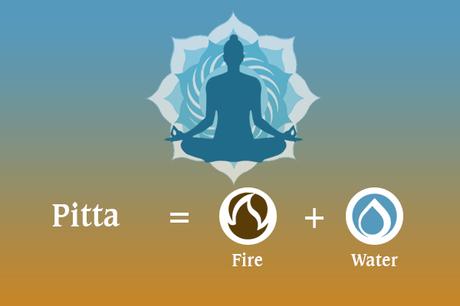ABSTRACT
Doshas are the humor and elements of the body which are responsible for a person's physiological, mental and emotional health. Each one of these doshas have their own respective functions in our body. These doshas are Vata, Pitta and Kapha. Where vata represents the movement and nervous system, pitta represents digestive elements or juices and kapha ensures the lubrication of joints. The imbalance in any of these elements will deteriorate one's health and give rise to various health conditions. In this article we will discuss the pitta dosha and how it can be managed using various ayurvedic herbs.
INTRODUCTION
Pitta dosha is generally said to be associated with the digestion and metabolism where pitta works by its properties of ushna(hot) and tikshna by initiating enzyme secretion. It has other properties according to the properties of their subtypes like ranjaka (coloring), bhrajaka, sadhaka, pachaka and alochaka pitta. Where pachaka pitta refers to digestion and this form of pitta exists primarily in the stomach and the intestine. Each one of them possesses different properties. Ayurvedic medicine is based on the idea that the world is made up of five elements- akash (space), vayu (air), agni (Fire), jala (water) and prithvi (earth).
A combination of each element results in three humors or doshas vata, pitta and kapha which are responsible for a person's physiological, mental and emotional health. Each and every person has a unique ratio of each dosha if a person is having pitta dosha in predominance while others may be mostly of vata and kapha dosha. Balance of all three doshas is adequate to maintain a healthy mind and body balance. As per the quotation samdoshas samagnisch sama dhatu mala kriya prasantamindriya mana swasth ityabhidhiyata. If our body is in proper balance with the proportion of doshas, agni and dhatu then the patient is said to be in a state of physical, social and mental well being.

Place of pitta dosha
The important site and location of the pitta dosha is as follows-- Sweda- rasa dhatu end product of food digestion
- Lasika- lymph
- Rudhira- blood
- Amashaya- small intestines are sites of pitta.
Pitta dosha is based on fire and water. It is commonly described as ushna(hot), laghu(light), tikshan(sharp) and sara(mobile). Grisham ritu or summer season is known as the pitta season. People with pitta dosha have intelligence, self master skills, good metabolism and healthy skin and hair. All metabolic activities, appetite, hunger, color, complexion and body's circulation are dependent on pitta dosha. When pitta is out of balance then the body may lead to many diseases like inflammation, acne and acidity.
SUB-TYPES OF PITTA DOSHA
TYPE OF PITTA DOSHA
LOCATION AND FUNCTION
Ranjaka
Located in the liver and spleen, it is responsible for converting rasa dhatu into rakta dhatu
Pachaka
Located in the stomach and intestine, it controls the digestive system
Sadhaka
Located in the head and heart. It attends mental functions such as knowledge and intelligence
Bhrajaka
Located in the skin, it gives color and complexion to the skin
Alochaka
Located in the eyes and helps in vision
Food to eat in pita
Pitta is said to be aggravated by the diet rich in rasa like amla (sour), lavan (salty) and katu (pungent) and is mitigated by madhura (sweet), tikta (bitter) and kashay (astringent) rasa. So, people having a pitta body type should refrain from having a diet rich in rasa amla (sour), lavan (salty) and katu (pungent) like grapes, papaya, onions, eggplant, almonds and various other things.
FOOD TO CONSUME IN PITTA BODY TYPEFOOD NOT TO CONSUME IN PITTA BODY TYPESweet and bitter vegetables like celery, carrots, cucumber and cabbage.
Spicy hot food, soy sauce, urad dal and things having salty and sour content.
Fruits like sweet ripe oranges, pear, bananas, melons and mangoes.
Cashew, sesame seeds, peanuts, egg yolk and thyme.
Herbs and spices like black pepper, cumin, cilantro and turmeric.
Honey, jaggery and white sugar. Spices like garlic, cloves, mustard seeds and hing.
Summer is said to be the season of pitta which is a combination of fire and water elements, pitta has the characteristics of being hot. When there is excess pitta in the body you may experience the following:-
- Feeling of heat generation in the body.
- Acid reflux
- Nausea
- Diarrhea
- Anger and hot flashes
- Excessive sweating
- Foul body odor
- Irritability
- Insomnia
- 10.Inflammation of the joints
According to ayurveda due to the inconsistency of them chronic diseases occur. There are 40 types of diseases caused by pitta dosha.
Among the forty nanatmaja vyadhi of pitta dosha some of the diseases are given below:
- Daha (burning)
- Amlaka
- Antar daaha (burning sensation inside the body)
- Ati sveda (excessive sweating)
- Ushmaadhikya (excessive temperature)
- Kaamla (jaundice)
- Jivadana (hemorrhage)
- Tamah pravesha (fainting)
Symptoms of Pitta Imbalance
- Daha- burning sensation
- Ushna - heat
- Sweda- perspiration
- Kandu- itching
- Kotha- putrefaction
- Srava- discharge
- Raaga - redness
General Treatment for pitta diseases
Importance of virechana in pitta imbalance
Purgation or virechana is the treatment for curing the pattika disease after administration virechana eliminates vitiated pitta from its root from the level of intestines. It also alleviates the entire vitiated pitta from other parts of the body.
AYURVEDIC TREATMENT
In ayurveda shamana is done by using madhura(sweet), tikta(bitter) and kashaya(astringent) rasa. The goal of treatment is to cleanse the body of undigested food. These cleansing mechanisms are described among panchkarma to maintain balance in the body.
Panchkarma includes five types of shodhana karmas.
- Vaman is done to detoxify vitiated kapha dosha.
- Virechana is done to detoxify vitiated pitta dosha.
- Basti is done to detoxify vitiated vata dosha.
- Nasya or nasal administration of medicated oil and herbs are used for relieving doshas from the head.
- Raktamokshana is done to expel out vitiated rakta dosha.
FORMULATIONS TO BALANCE VITIATED PITTA DOSHA.
ASANAS TO MAINTAIN HEALTHY PITTA BALANCE
Some effective herbs by planet ayurveda to balance pitta dosha1. Pitta Balance
This herbal formulation is made up of rasaushadhi like jahar mohra pishti, kaharava pishti, akik pishti, mukta pishti and giloy satva( Tinospora cordifolia) herb. Akik pishti and mukta pishti are helpful in balancing excess acid in the stomach and provides immediate relief from acidity and heartburn but also improves digestion and reduces constipation.
Dosage - 1 to 2 capsules twice daily with water after a meal.
2. Panchatikta kwath
This formulation is made of guduchi( Tinospora cordifolia), nimba( Azadirachta indica), patola( Cucumis acutangulus), kantakari( Solanum virginianum) and parpata( Fumaria indica) etc. which is useful in reducing inflammation and fever like conditions.
Dosage - 2 tsp before food with equal amount of water
3. Hankh bhasma
It is made of the conch or sea shell for managing conditions like acid reflux, also called GERD. Sankha bhasma has a kshar (alkaline) property which helps in neutralizing the excess acid production. It works by its sheeta (cold) property. It is useful in controlling acidity, abdominal pain and ibs like condition.
Dosage - 125-250 mg twice a day
4. Praval panchamrit ras
This herbal formulation is in the form of tablet or powder formed by Mukta bhasma, shankh bhasma, shukti bhasma, praval bhasma and the latex of arka. It has a calming effect on curing bloating, anorexia, ascites, indigestion and gastritis like conditions and is helpful in balancing vata and kapha dosha
Dosage-2 tablets twice daily with honey, ghee and milk after a meal.
CONCLUSION
Pitta dosha is one of the three doshas of our body which has its own natural properties and functioning in the body. When these doshas get out of balance they cause different health conditions which are aggravated by the consumption of rasa opposite to that of their nature. Pitta dosha is similarly maintained by giving up on certain items leading to its aggravation like amla(sour), lavan(salt) and katu(pungent) rasa and also by shodhana(detoxification) and shamna(pacification).

